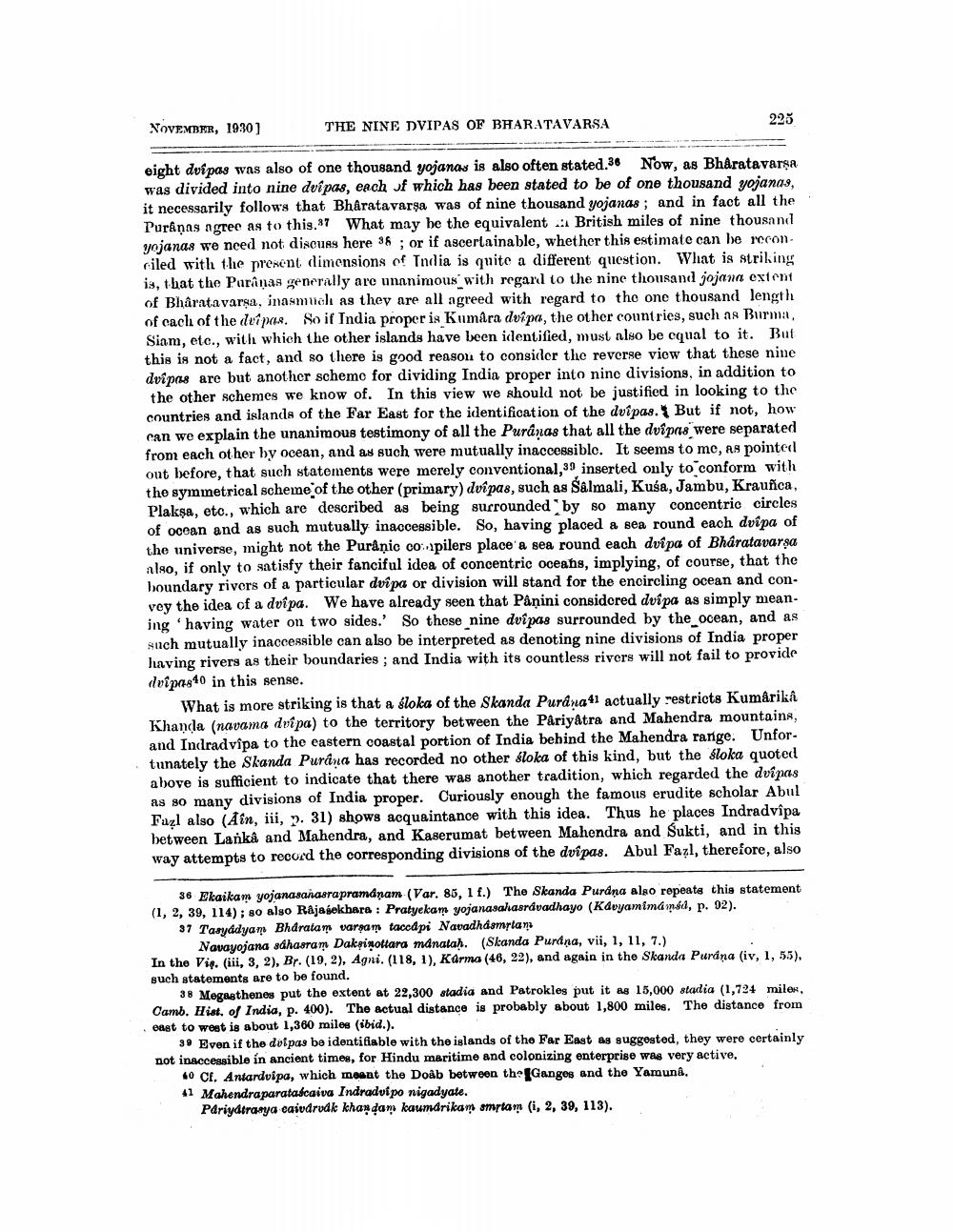________________
NOVEMBER, 1930)
THE NINE DVIPAS OF BHARATAVARSA
225
eight dvipas was also of one thousand yojanas is also often stated.36 Now, as Bharatavarşa was divided into nine dvi pas, each of which has been stated to be of one thousand yojanas, it necessarily follows that Bharatavarşa was of nine thousand yojanas; and in fact all the Puranas ngree as to this.87 What may be the equivalent - British miles of nine thousand yojanas we need not discuss here 36 ; or if ascertainable, whether this estimate can be recon. ciled with the present dimensions of Tndia is quite a different question. What is striking is, that the Paranas generally are unanimous with regard to the nine thousand jojana extent of Bhâratavarga, inasmuch as they are all agreed with regard to the one thousand length of each of the dvipar. So if India proper is Kumara dvipa, the other countries, such as Burma, Siam, etc., with which the other islands have been identified, must also be equal to it. But this is not a fact, and so there is good reason to consider the reverse view that these nine dvipas are but another scheme for dividing India proper into nine divisions, in addition to the other schemes we know of. In this view we should not be justified in looking to the countries and islands of the Far East for the identification of the dvipas. But if not, how can we explain the unanimous testimony of all the Puranas that all the dvipas were separated from each other by ocean, and as such were mutually inaccessible. It seems to me, as pointed out before, that such statements were merely conventional,39 inserted only to conform with the symmetrical scheme of the other (primary) dvipas, such as Salmali, Kusa, Jambu, Krauńca, Plakşa, etc., which are described as being surrounded by so many concentric circles of ocean and as such mutually inaccessible. So, having placed a sea round each dvípa of the universe, might not the Purâņic copilers place'a sea round each dvípa of Bharatavarsa also, if only to satisfy their fanciful idea of concentric oceans, implying, of course, that the boundary rivers of a particular dvi pa or division will stand for the encircling ocean and convoy the idea of a dvipa. We have already seen that Panini considered dvipa as simply meaning having water on two sides.' So these nine dvipas surrounded by the ocean, and as such mutually inaccessible can also be interpreted as denoting nine divisions of India proper having rivers as their boundaries; and India with its countless rivers will not fail to provide dvipas40 in this sense.
What is more striking is that a sloka of the Skanda Purana 41 actually restricts Kumarikh Khandla (navama dvípa) to the territory between the Pariyatra and Mahendra mountains, and Indiradvipa to the eastern coastal portion of India behind the Mahendra range. Unfortunately the Skanda Purana has recorded no other sloka of this kind, but the sloka quoted above is sufficient to indicate that there was another tradition, which regarded the dvipas as so many divisions of India proper. Curiously enough the famous erudite scholar Abul Fazl also (Ain, iii, 9. 31) shows acquaintance with this idea. Thus he places Indradvîpa between Lanka and Mahendra, and Kaserumat between Mahendra and Sukti, and in this way attempts to record the corresponding divisions of the dvipas. Abul Fazl, therefore, also
36 Ekaikam yojanasahaarapramdnam (Var. 85, 1 f.) The Skanda Purdna also repeate this statement (1, 2, 39, 114); 80 also Rajasekhara : Pratyekam yojanasahasrdvadhayo (Kavyamimámád, p. 92). 37 Tasyddyan Bhdratam varam taccdpi Navadhaamsiana
Navayojana sdhasram Daksinottara mdnatah. (Skanda Purdna, vii, 1, 11, 7.) In the Vip. (iii, 3, 2), Br. (19,2), Agni. (118, 1), Karma (46, 22), and again in the Skanda Purana (iv, 1, 55), such statements are to be found.
38 Megasthenes put the extent at 22,300 stadia and Patrokles put it as 15,000 stadia (1,724 miler, Camb. Hist. of India, p. 400). The actual distance is probably about 1,800 miles. The distance from east to west is about 1,360 miles (ibid.).
39 Even if the dofpas be identifiable with the islands of the Far East as suggested, they were certainly not inaccessible in ancient times, for Hindu maritime and colonizing enterprise was very active,
40 CE. Antardvipa, which meant the Dodb between the Ganges and the Yamuna. 41 Mahendraparatascaiva Indradvipo nigadyate.
Pariydtranya caivdrudle khandam kaumdrikam emptam (1, 2, 39, 113).




